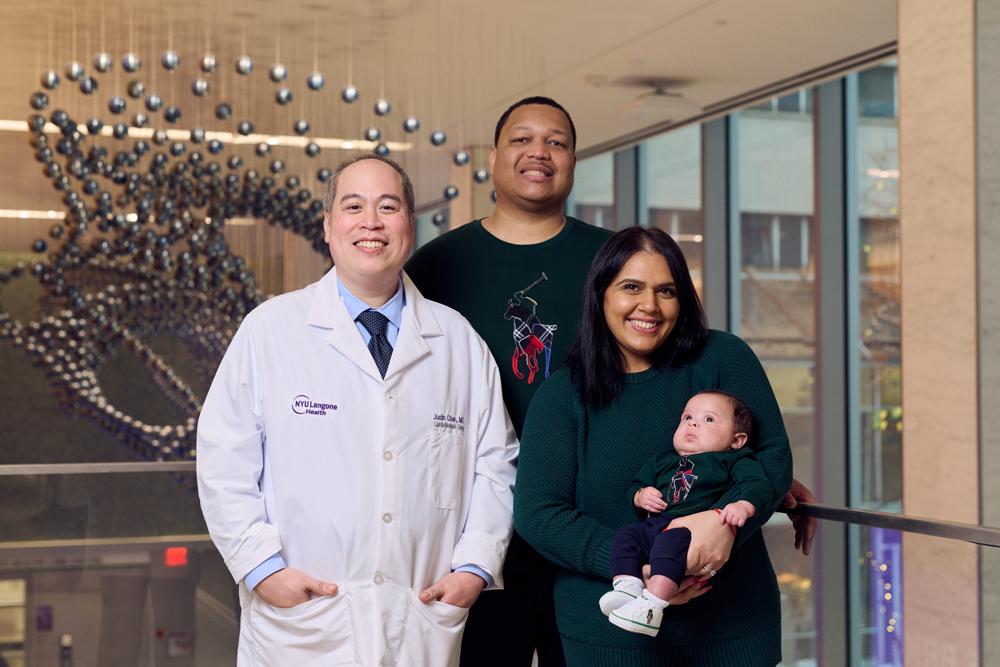Dr. Justin C. Chan Performed Rare, High-Risk Lung Surgery After She Delivered Her Baby via Emergency Cesarean Procedure

Photo: Joe Carrotta
Walking up the subway stairs at 33 weeks pregnant is rarely easy. But for Alexandra Jones, it was unexpectedly impossible.
Her chest ached. She was dizzy. She couldn’t catch her breath. Her husband summoned a cab to take her the rest of the way to her routine obstetric appointment, scheduled for August 25. An ultrasound was worrying: although the baby had a heartbeat, he wasn’t moving. She was immediately sent to NYU Langone’s Ronald O. Perelman Center for Emergency Services.
More tests showed that the baby was fine. But Jones was not. Her heart was racing, her oxygen levels were low, and she still had an odd feeling in her chest. Blood work and a CT scan revealed the cause: pulmonary embolisms, meaning blood clots in the lungs.
Throughout her pregnancy, Jones had been taking blood thinners for a rare blood clotting disorder known as antithrombin III deficiency. Doctors adjusted her medications and transferred her to the intensive care unit (ICU) at Tisch Hospital. Two days later, as she walked from her ICU bed to the restroom, she passed out. “When I woke up, I was screaming for help and asking if the baby was OK,” she said. “I was in total shock.”
The clots were not responding to medication and were blocking blood flow to the heart, placing Jones at high risk of heart failure. The clots had to be removed. “This was a high-risk pregnancy, and the health of the mother deteriorated in an unexpected way,” said cardiothoracic surgeon Justin C. Chan, MD. “Our doctors worked together to create a treatment plan that carefully considered how complex her condition was and how to best preserve the health of both mother and baby.”
Life Support and Complex, Lifesaving Surgery
At first, the care team determined an interventional radiology embolectomy, a procedure using a catheter with suction at the tip to remove blood clots in the lungs, would be the safest treatment option for Jones while she was pregnant. But the procedure did not go as planned. Jones’s blood pressure unexpectedly and dangerously dropped, and so did the baby’s heart rate. Both of their lives were in danger.
NYU Langone specialists swiftly responded. Her baby, Jameson, was delivered via an emergency cesarean procedure performed by maternal–fetal medicine specialist Garfield Clunie, MD. Meanwhile, cardiac surgeon Deane E. Smith, MD, placed Jones on extracorporeal membrane oxygenation (ECMO), a mechanical device that pumps and circulates blood, taking over the work of the heart and lungs.
Once her baby was delivered and she was responding well to ECMO, Dr. Chan had to address the source of the problem: those blood clots. Jones was fortunate—when it comes to treating blood clots in the lungs, Dr. Chan is one of the world’s most experienced surgeons. “This procedure, pulmonary embolectomy, is pretty uncommon, but it was our best chance of ensuring her survival,” he said.
Pulmonary embolectomy is a high-risk procedure. It required placing Jones on a special heart–lung machine that drains the blood and then artificially pumps it through the body while avoiding the lungs and heart. This allowed Dr. Chan and his surgical team to operate in the chest cavity without excessive bleeding, which could obstruct their view.
“Our doctors worked together to create a treatment plan that carefully considered how complex her condition was and how to best preserve the health of both mother and baby.”
—Justin C. Chan, MD
The procedure took about seven hours and required Dr. Chan to stop Jones’s heart for 60 minutes. “We opened the main pulmonary artery, which was almost completely blocked by blood clots, and removed them piece by piece,” said Dr. Chan. He and his team also removed clots from 10 blood vessels branching off the pulmonary artery, 5 on each side. With the clots gone, Jones was removed from ECMO and the heart–lung machine simultaneously. A day later, she was taken off the ventilator and she started breathing on her own.
“She recovered quite remarkably from there,” said Dr. Chan.
Mother and Baby Reunited
When Jones woke, three days had passed. She was astonished to learn all that had happened, but what she wanted most of all was to see Jameson. Born on August 28 at 34 weeks, he weighed 4 pounds, 3 ounces, and needed a ventilator for his first 24 hours. He was still in the Neonatal Intensive Care Unit (NICU) at Tisch Hospital, and Jones had to stay in the ICU. So the NICU nurses did the next best thing, and Jones was able to meet her son for the first time via FaceTime.
“He seemed perfect and so at ease,” she said. “It gave me a lot of strength.”
The next day, Jones was strong enough to see him in person.
“Alexandra is such an amazing person,” said Dr. Chan. “She was completely focused on her recovery so she could be with her family.”
Jones spent a few extra days in the hospital. Jameson was able to go home on September 23 after four weeks in the NICU. Now that everyone is home and well, Jones is looking forward to the rest of her family meeting Jameson and to going for walks outside with the baby. She continues to see Dr. Chan and several other NYU Langone providers for follow-up care.
“I speak to Dr. Chan often,” said Jones. “He was so calm and confident while he was caring for me at the hospital. He helped save my life, and I’m just so grateful to be alive.”
Watch more from NBC New York.


